I can’t remember the moment I decided to cloth diaper in an RV. It wasn’t something I planned for years before having #BabyNomad. But during the inevitable nesting phase of my pregnancy, I decided to look into it as an option.
I had a ton of questions. To be honest, I wasn’t sure cloth diapering was practical for me. I like doing things that are environmentally-friendly and economical. But I only have so many hours each day, and my time is valuable to me. So I have to weigh everything together. If something is going to take more time than I think it’s worth, like homemade baby food, then it’s a no-go.
When I first started researching cloth diapering and whether it was something that could mesh with the fulltime RV lifestyle, I got overwhelmed and gave up. Why are there so many types of cloth diapers? How many do I need to buy? How do you even put them on? Do I really have to use a special kind of laundry soap and diaper cream?
But I came back to my research again and again, tackling one little question at a time. As I result, I found the exact answers I needed, as well as confidence that cloth diapering was right for me, my baby, and our RVing lifestyle.
I waited to write this article for well over a year. I’ve finally reached the point where I don’t feel like a newbie. I know the pros and cons of cloth diapers from experience, and I’m ready to share them with you. Let’s dive in!
Here are the questions I’m going to answer in this cloth diapering guide:
- Can I really cloth diaper as a fulltime RV traveler?
- I know I’ll eliminate waste, but can I really save money with cloth diapering?
- What kind of cloth diapers should I get and how many do I need to buy?
- How do I wash cloth diapers in my RV?
- But what do I do with dirty diapers between washes?
- How do I deal with diaper rash?
- What are the downsides to cloth diapering in an RV?
- Where do I go if I have more questions?
Let’s talk about our babies’ bodily functions!
Note: This article includes affiliate links. If you get excited about any of the products featured here, we’d love it if you’d shop via our links. This will encourage us to continue investing time in creating useful content!
Can I really cloth diaper as a fulltime RV traveler?
Let me get this out of the way. If you want to badly enough, then you can cloth diaper as a fulltime RV traveler. The routines you develop through research will make the process simple and cost-efficient, or time-consuming and expensive. Like anything else, there are pitfalls to be avoided. Keep reading to learn what they are.
I know I’ll eliminate waste, but can I really save money with cloth diapering?
Spend some time surfing the web, and you’ll find sharply different claims about cloth diaper cost savings. I don’t know what those people did because I’ve only ever spent $240 on cloth diapers. And actually I spent $0 because friends and family purchased them all through Caspian’s gift registry.
Yes, there have been other costs. They may shock you. About $24 for GroVia BioLiners (that’s two rolls). Another $12 or so for GroVia cloth wipes.
There are minimal electricity and water costs for “stick and brick” people, but not typically for full-time RVers. If you’re paying the weekly or monthly rate as you travel, utilities will almost always be included.
Detergent? Costs have been minimal.
On the high side, we’ll say the cloth diapers, accessories, and laundry needs have totaled about $300.
If you’re going through a $25 box of disposable diapers every six days (box of 66 diapers divided by 11/day for newborns), then you’ll spend $300 in 72 days. You do the math. Depending on the quality of disposable diapers you purchase, I’ve seen the “lifetime” cost for one child anywhere from $1,500-2,000.
$2,000 versus $300. Even if the $2,000 number is high, the choice seems obvious from a purely economical standpoint.
What kind of cloth diapers should I get and how many do I need to buy?
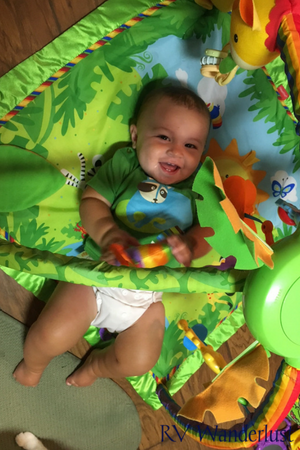 I got hung up and overwhelmed at this point in the research process. There are so many different styles of cloth diapers. And within each style, every mother swears by a particular brand.
I got hung up and overwhelmed at this point in the research process. There are so many different styles of cloth diapers. And within each style, every mother swears by a particular brand.
Rather than doing an exhaustive analysis of the various cloth diaper types and brands, I’m going to tell you what has worked for me. I am so pleased with the cloth diaper brand I chose that I feel 100% comfortable recommending it to you.
With the disclaimer that every baby’s adorable bottom is a slightly different size with varying sensitivity levels. Like anything else, what worked for me may not work for you.
I exclusively use the Flip System by bumGenius. These cloth diapers have two parts to them: a waterproof cover and a cloth insert. I have a total of 10 covers and 30 inserts (five packs).

When I started cloth diapering one-month-old Caspian, I could reuse the same cover multiple times, as long as it wasn’t soiled or wet. As he got bigger, I had to make two changes:
- Changing covers more frequently. They would get damp, and the dampness would irritate Caspian’s skin.
- Using two cloth inserts at night. He had started waking up with wet pants, but adding another insert at bedtime solved that problem. Flip also has a Night Time Organic insert, which has heavy duty absorbency.
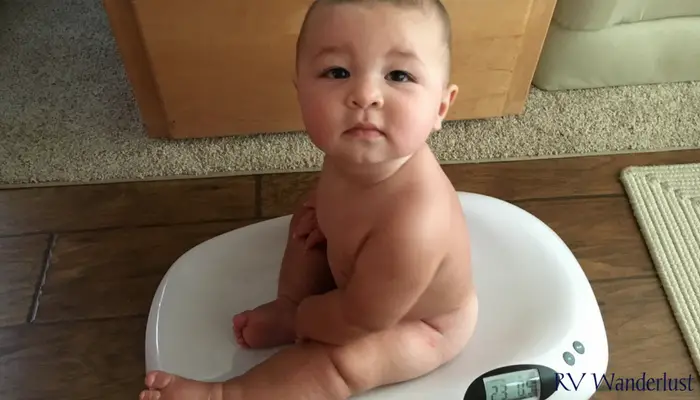
The awesome thing about these diapers is that they are one size. They have a genius snap-down system that allows you to change the fit as your baby grows, anywhere between 8-35 lb. Super easy to use, with big cost savings compared to other multi-size cloth diaper systems.
I learned how to use the diapers through YouTube. I watched a few to get my bearings, including this one.
How do I wash cloth diapers in my RV?
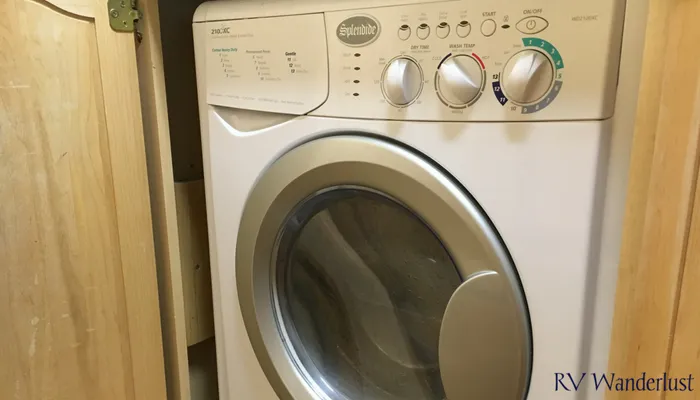
If you have a washer/dryer combo in your RV, then you are good to go. With our Splendide 2100XC, this is my wash routine:
- Permanent press express wash on cold (setting #9). You only need to add a small amount of detergent for this cycle.
- If I have any, I add other white laundry that needs to be washed, like socks, wash cloths, white onesies, etc. The next cycle will be hot, so I avoid anything that might bleed. I also avoid adding blankets or other bulky items that could get tangled up with the diaper inserts.
- Cotton heavy duty regular wash on hot (setting #3). This is the disinfectant cycle, so it’s important that you use hot water and an adequate amount of detergent for your washer size.
- Remove covers and let them air dry (I usually hang them over the shower).
- Dry inserts on setting #10. I don’t know why I don’t use #5 (cotton), as that would probably make more sense. I don’t think it really matters for this cycle!
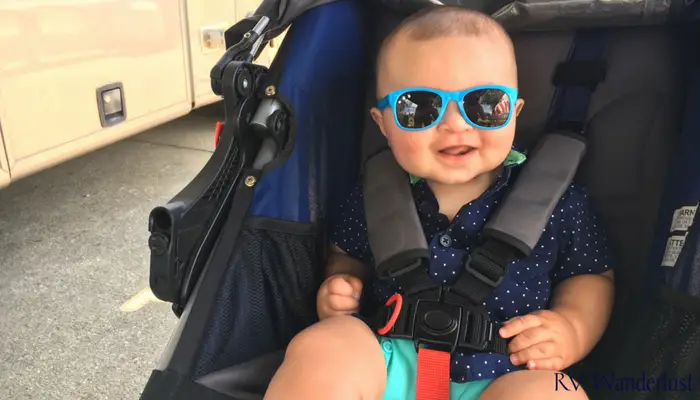
For detergent, I use Tide Plus Bleach Powder HE. From all the research I did, Tide Powder detergent is one of the best you can use for cloth diapers. The bleach version isn’t necessary, but it gives a good boost for keeping baby’s diapers clean.
With only 10 covers and 30 inserts, I’m sure you’re wondering how often I have to wash. I wash Caspian’s cloth diapers every three days. I start the load when I’m down to a couple of diapers, and then I’m good to go for another three days.
Since you’ll be using your washer/dryer a lot more, don’t forget to maintain your machine properly.
➡️ Keep reading: How to Properly Clean and Maintain Your RV’s Washer/Dryer Combo
But what do I do with dirty diapers between washes?
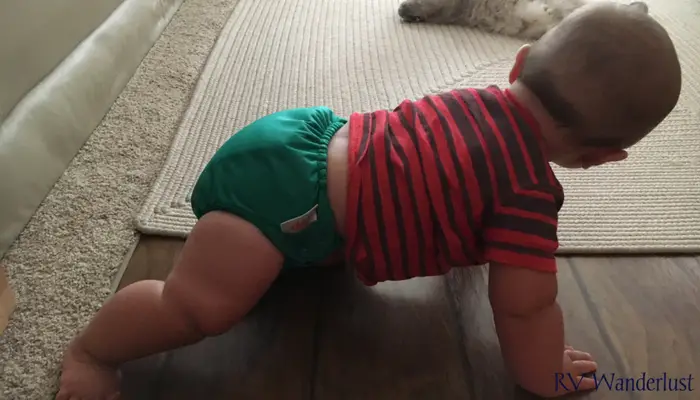
I keep a Kanga Care wet bag in the shower. Wet covers and diapers go straight in after diapers changes. I take soiled covers and diapers into the bathroom, where I spray the poop off into the toilet (our RV toilet came with a sprayer, years before I knew it would come in this handy!).
This may go without saying, but the sooner you get the dirty diaper off your baby, the easier it will be to wash out. Get your one-year-old doing rolls and squats in a dirty diaper, and you’re not in for much fun. I keep a butter knife type thing in the bathroom for scrape jobs, but fortunately I haven’t had to use it very often.
(Even after 20 months, the potty talk still makes me uncomfortable. ?)
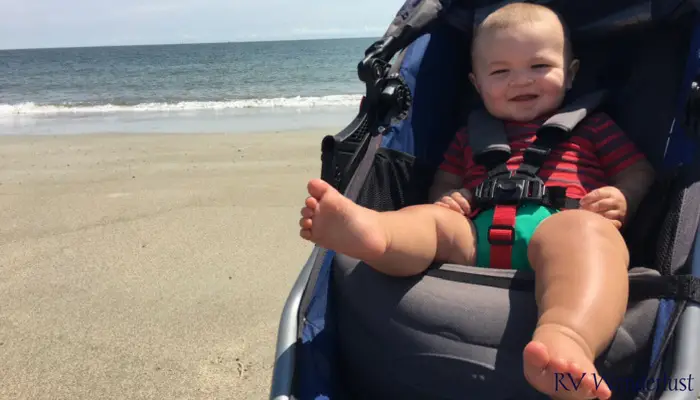
A few wet bag pro tips:
- Don’t forget to throw it in when you wash your diapers. I let mine air dry with the covers.
- The wet bag tends to attract tiny gnats, depending on the time of year and area you’re in. I spray an essential oil blend on the bag whenever I put a new diaper in. My blend is water, peppermint, rosemary, melaleuca, geranium, patchouli, and cedarwood. It isn’t bulletproof, but it helps a ton.
- I also keep a small GroVia wet bag in the diaper bag, to deal with wet/soiled diapers on the go.
➡️ Hop over to Amazon to read wet bag reviews or purchase.
How do I deal with diaper rash?
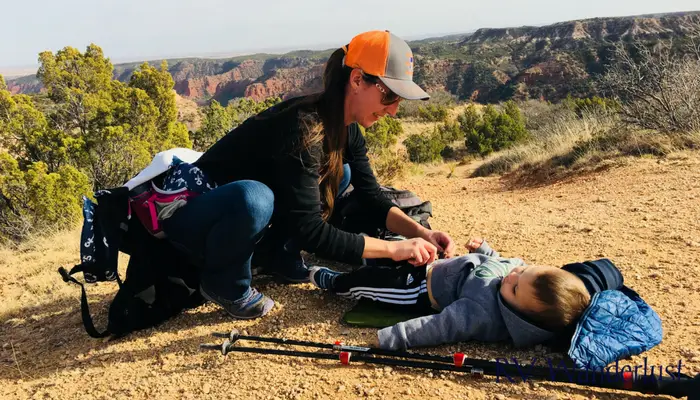
You have to be careful how you use diaper cream when you cloth diaper. You can easily ruin the absorbency of your diapers if you aren’t careful. You have two options:
- Use a cloth diaper-friendly diaper cream.
- Use your diaper cream of choice with a liner.
I’ve done both, and both options have pros and cons. Right now I’m using Boudreaux’s All Natural Butt Paste (green tube). I don’t have to worry about my cloth diapers at all, which is great, and I love the idea of using a product made of natural ingredients. However–at least in Caspian’s case–there’s no question that the All Natural cream does not work as well.
Since I have the All Natural version, I try to be proactive, changing his cloth diapers regularly and applying coconut oil at night during his baby massage.
Option #2: I’ve also used Boudreaux’s regular Butt Paste (yellow tube). It has always worked really well when Caspian has a rash. And let’s face it, when our tiny human is squirming with a red bottom, all you want is for them to feel better.
The downside to the regular Butt Paste is that it contains ingredients that will mess up the absorbency of your cloth diapers inserts. Because of that, you need to use a liner.
The good news is that liners are inexpensive and easy to use. I like GroVia’s BioLiners, which are usually $10-12 a roll (I’m still on my second roll, so they last forever). To use, you pull one liner off the roll like you would a paper towel, and lay it on top of the cloth diaper insert. Make sure it doesn’t bunch up as you’re securing the cloth diaper, and then you’re good to go.
I really don’t like the liner step when I’m on the go, which is why I’ve always kept the All Natural diaper cream in my diaper bag. That way, I never need a liner when I’m attempting a floor diaper change in another questionably clean bathroom.
What are the downsides to cloth diapering in an RV?
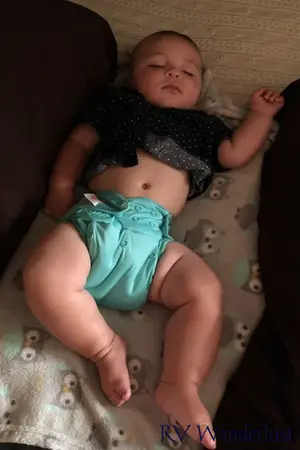
I’m surprised when people are surprised that I cloth diaper in an RV. Since we have a washer/dryer, I don’t think it’s any harder than it would be with a “normal” lifestyle.
The main downside of cloth diapering is that it takes extra time. Having said that, I’m extremely jealous of how I spend my time. And in this case, I consider the extra loads of laundry to be well worth the $1700ish of savings over a couple of years. That’s a whole lot of money.
Other than that, you have to stay flexible. This year, we’ve been doing a ton of dry camping. There’s no reasonable way for me to cloth diaper while we dry camp, between the water it takes to rinse diapers pre-wash and then using the actual washing machine.
The good news is I’ve run the numbers here, too. At Caspian’s current age (20 months), a $20 box of diapers will last almost two weeks. When we’re paying for full hookups, we’re typically spending $25-30 per night. So the cost savings are obvious.
Do I feel bad about my environmental impact when I stop cloth diapering in order to dry camp? No. You know why? We conserve everything when we dry camp. Our power and water usage is extraordinarily smaller than when we’re plugged in, even with cloth diapers factored in.
So, like I said, be flexible. Follow your heart and do the Good you can, where you can. There are many ways to do good in your unique circumstances.
Where do I go if I have more questions?
I’ve tried to answer as many common questions as I can, but I keep thinking of more. Maybe you don’t have a washer/dryer in your RV or maybe you don’t have a sprayer on your toilet. In either case (and many others), you’re not alone and there are solutions for you.
If you leave a question in a comment, then I will answer it to the best of my ability. If it seems like a common hurdle, then I’ll edit this article to answer more fully.
Beyond that, I’ve saved the best resource for last. It’s called Fluff Love & CD Science. The Facebook group has nearly 30,000 members. It’s become so large and popular that a website was born from it. Here are the pages that really helped me:
There is a mind-blowing amount of information on this website, written in a friendly and understandable way. If you’re having a weird problem with your cloth diapers, like they smell bad, then this group of moms will help you troubleshoot so you can keep cloth diapering. It’s really a beautiful resource, and I can’t say enough good things about what they’re doing.
And though it isn’t as active (yet?!), Fulltimers Cloth Diapering Mommas Group is a Facebook community of 150+ RVing mothers who can offer support and insight.
You’re doing a great job, momma
You don’t have to start cloth diapering immediately. When I was pregnant, another cloth diapering mom told me I should wait until Caspian was one-month-old to put cloth diapers on him. She said there were so many things for me to worry about during that first month, and I didn’t need to add something else. I am so glad I took her advice. And while Caspian was a big baby (8 lb. 10 oz…natural birth), keep in mind that the Flips only fit babies 8 lb. and up. That one-month mark is a sweet spot, all around.
No matter what you decide, I applaud you for considering cloth diapering in your RV. You can do it, but you should feel free to do whatever is best for your baby and family overall. I’m here to help in any way I can.
➡️ Keep reading: Making Room for Baby in an RV
➡️ Keep reading: Making Room for a One Year Old in an RV
-B

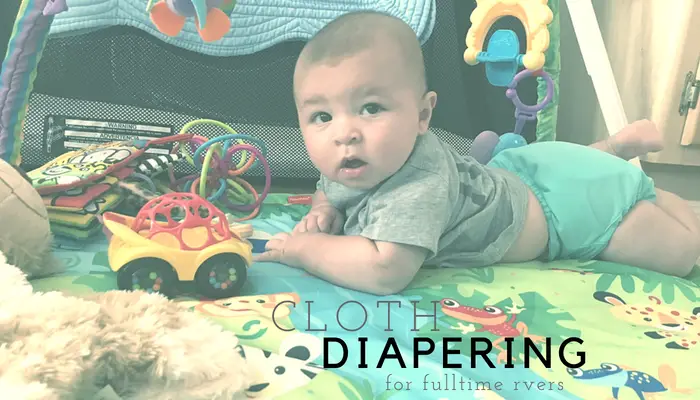
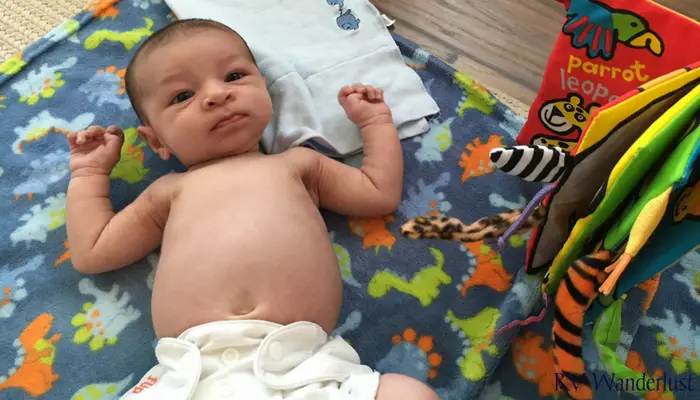
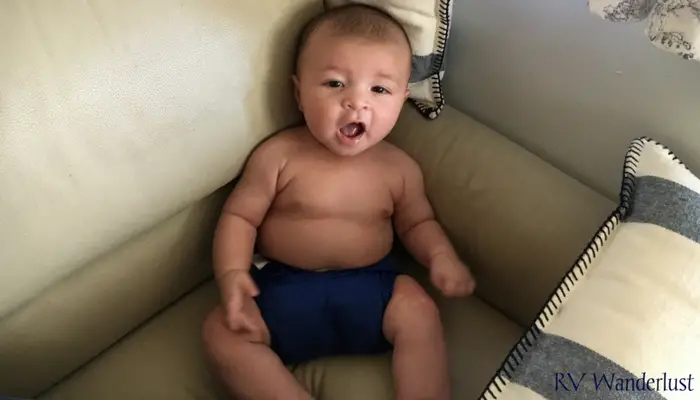
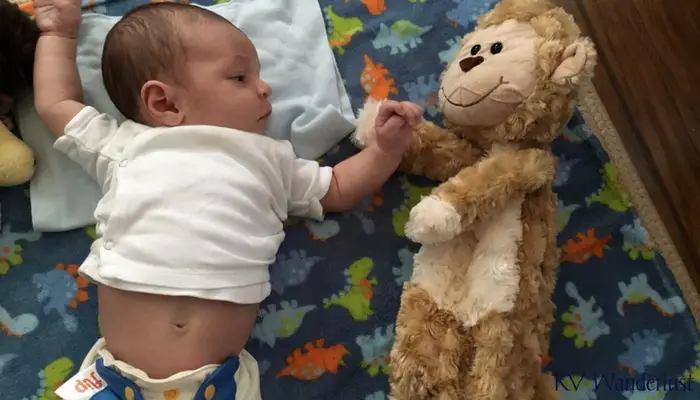
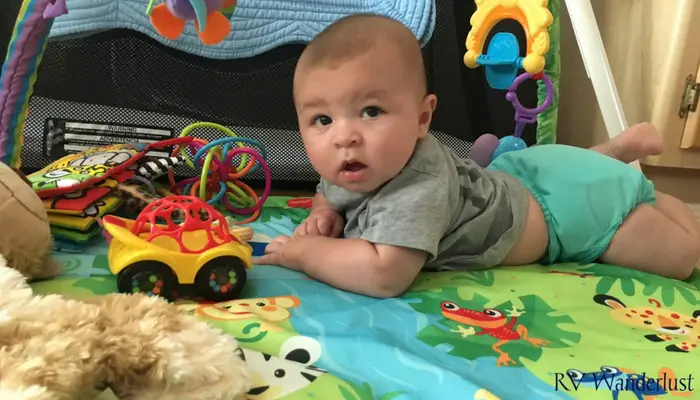
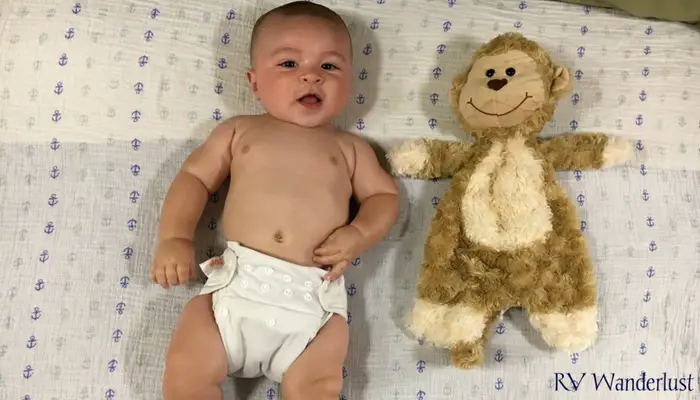

Leave a Reply